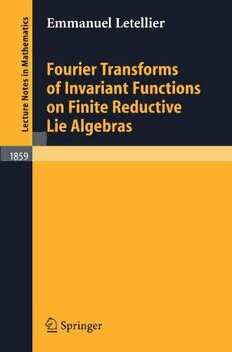
Fourier Transforms of Invariant Functions on Finite Reductive Lie Algebras PDF
Preview Fourier Transforms of Invariant Functions on Finite Reductive Lie Algebras
1859 Lecture Notes in Mathematics Editors: J.--M.Morel,Cachan F.Takens,Groningen B.Teissier,Paris Emmanuel Letellier Fourier Transforms of Invariant Functions on Finite Reductive Lie Algebras 123 Author EmmanuelLetellier DepartmentofMathematics SophiaUniversity Kioicho,Chiyodaku Tokyo102-8554 Japan e-mail:[email protected] LibraryofCongressControlNumber:2004115717 MathematicsSubjectClassification(2000):20C33 ISSN0075-8434 ISBN3-540-24020-9SpringerBerlinHeidelbergNewYork DOI:10.1007/b104209 Thisworkissubjecttocopyright.Allrightsarereserved,whetherthewholeorpartofthematerialis concerned,specificallytherightsoftranslation,reprinting,reuseofillustrations,recitation,broadcasting, reproductiononmicrofilmorinanyotherway,andstorageindatabanks.Duplicationofthispublication orpartsthereofispermittedonlyundertheprovisionsoftheGermanCopyrightLawofSeptember9, 1965, initscurrentversion,andpermissionforusemustalwaysbeobtainedfromSpringer.Violationsareliable forprosecutionundertheGermanCopyrightLaw. SpringerisapartofSpringerScience+BusinessMedia http://www.springeronline.com (cid:1)c Springer-VerlagBerlinHeidelberg2005 PrintedinGermany Theuseofgeneraldescriptivenames,registerednames,trademarks,etc.inthispublicationdoesnotimply, evenintheabsenceofaspecificstatement,thatsuchnamesareexemptfromtherelevantprotectivelaws andregulationsandthereforefreeforgeneraluse. Typesetting:Camera-readyTEXoutputbytheauthors 41/3142/du-543210-Printedonacid-freepaper To my parents Preface The present work is about the study of the trigonometric sums on finite reductiveLiealgebrasofChevalley’stypeinthesenseof[Spr76].Thissubject has been introduced to me by my supervisors Gus Lehrer and Jean Michel in connection with [Leh96][Leh97] while I was starting my PhD under a co- tutelleagreementbetweentheuniversityParis6andtheuniversityofSydney. The required background is the standard knowledge of the theory of con- nected reductive groups and finite groups of Lie type [Spr]. ItisagreatpleasuretothankmysupervisorsGusLehrerandJeanMichel for their precious advices throughout the elaboration of this work. I am also verygratefulto allthe otherswho redthe firstdrafts andsuggestedimprove- ments, particularly A. Henderson, T. Shoji, J. van Hamel and the editor. Finally I wouldlike to thank G. Lusztig who inventedthe theory I use inthis book. The preparation of this work has been conducted at the following places: “Equipedesgroupesfinis”(Institutde math´ematiquesde Jussieu,Paris),uni- versity of Sydney, LAMFA (universit´e de Picardie Jules-Verne), Sophia uni- versity (Tokyo). It is a pleasure to thank the previously named institutes for their hospitality. I am grateful to the AEAP (Australian European Award Program),the Frenchministry ofresearchand to JSPS(JapaneseSociety for the Promotion of Science) for their generous support. Tokyo, July 2004 Emmanuel Letellier Contents 1 Introduction............................................... 1 2 Connected Reductive Groups and Their Lie Algebras...... 5 2.1 Notation and Background ................................ 5 2.1.1 H-Varieties and Adjoint Action of H on H ........... 6 2.1.4 Reductive Groups ................................. 7 2.1.10 About Intersections of Lie Algebras of Closed Subgroups of G ................................... 9 2.1.16 F -Structures ..................................... 10 q 2.2 Chevalley Formulas...................................... 11 2.3 The Lie Algebra of Z ................................... 13 G 2.4 Existence of Chevalley Bases on G(cid:1) ........................ 15 2.5 Existence of Non-degenerate G-Invariant Bilinear Forms on G . 18 2.6 Centralizers............................................. 24 2.7 The Varieties G and G ............................... 30 uni nil 3 Deligne-Lusztig Induction ................................. 33 3.1 The Space of GF-Invariant Functions on GF ................ 33 3.2 Deligne-Lusztig Induction: Definition and Basic Properties.... 36 3.2.1 Deligne-Lusztig Induction: The Group Case........... 36 3.2.8 Deligne-Lusztig Induction: The Lie Algebra Case ...... 38 3.2.17 Basic Properties of RG .......................... 40 L⊂P 4 Local Systems and Perverse Sheaves....................... 45 4.1 Simple Perverse Sheaves, Intersection Cohomology Complexes. 47 4.2 H-Equivariance ......................................... 49 4.3 Locally (Iso)trivial Principal H-Bundles .................... 54 4.4 F-Equivariant Sheaves and Complexes ..................... 57 X Contents 5 Geometrical Induction..................................... 61 5.1 Admissible Complexes and Orbital Perverse Sheaves on G .... 62 5.1.1 Parabolic Induction of Equivariant Perverse Sheaves ... 63 5.1.9 The Complexes indG K(Σ,E) ..................... 64 L⊂P 5.1.14 The Complexes indG K(Σ,E) Are G-Equivariant L⊂P Perverse Sheaves .................................. 66 5.1.26 When the ComplexesindG K(Σ,E)Are Intersection L⊂P Cohomology Complexes ............................ 73 5.1.41 Restriction of indG K(Σ,E) to G with σ ∈z(G)..... 79 L⊂P σ 5.1.51 Introducing Frobenius.............................. 81 5.1.56 Admissible Complexes (or Character Sheaves) on G .... 84 5.1.72 Orbital Perverse Sheaves: The Fundamental Theorem .. 86 5.2 Deligne-Fourier Transforms and Admissible Complexes ....... 89 5.3 Endomorphism Algebra of Lusztig Complexes............... 96 5.4 Geometrical Induction: Definition.......................... 99 5.4.1 Preliminaries .....................................100 5.4.10 Geometrical Induction .............................103 5.5 Deligne-Lusztig Induction and Geometrical Induction ........106 5.5.1 Generalized Green Functions........................106 5.5.9 The Character Formula ............................110 5.5.11 Generalized Green Functions and Two-Variable Green Functions ........................................111 5.5.14 Geometrical Induction and Deligne-Lusztig Induction ..112 6 Deligne-Lusztig Induction and Fourier Transforms .........115 6.1 Frobenius Action on the Parabolic Induction of Cuspidal Orbital Perverse Sheaves .................................115 6.1.1 The Functor indS×G :M (S×L)→Db(S×G) .....116 S×L,P L c 6.1.2 The Complexes indS×G K(Z×C,E)................116 S×L,P 6.1.15 The Complexes K1 and K2 .........................121 6.1.19 The Character Formula ............................122 6.1.54 Deligne-Lusztig Induction and Geometrical Induction ..137 6.2 On the Conjecture 3.2.30 .................................139 6.2.1 Reduction of 3.2.30 to the Case of Nilpotently Supported Cuspidal Functions ......................139 6.2.7 The Main Results .................................142 6.2.20 Lusztig Constants: A Formula.......................146 Contents XI 7 Fourier Transforms of the Characteristic Functions of the Adjoint Orbits.............................................151 7.1 Preliminaries............................................151 7.1.1 A Decomposition of C(GF) .........................151 7.1.6 A Geometric Analogue of 3.2.24.....................153 7.2 Fourier Transforms of the Characteristic Functions of the Adjoint Orbits ..........................................154 7.3 Fourier Transforms of the Characteristic Functions of the Semi-simple Orbits ......................................157 References.....................................................159 Index..........................................................163
